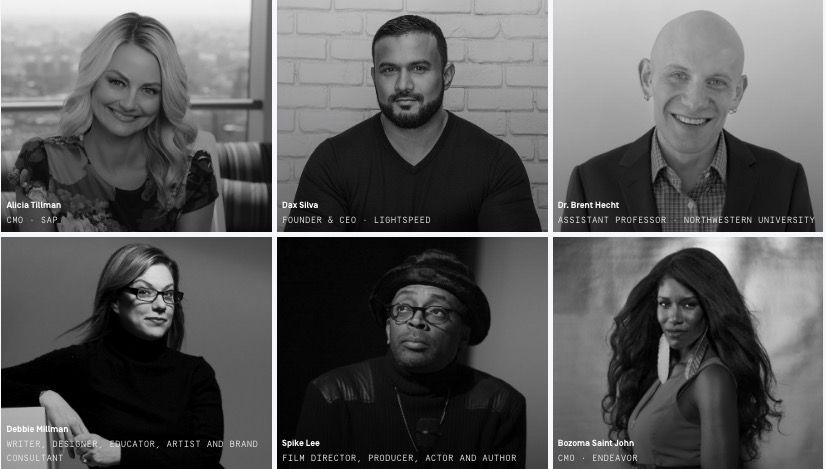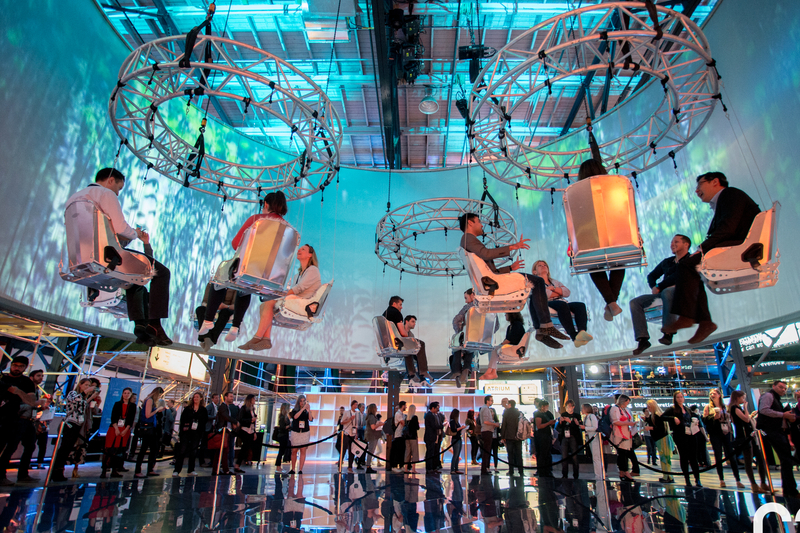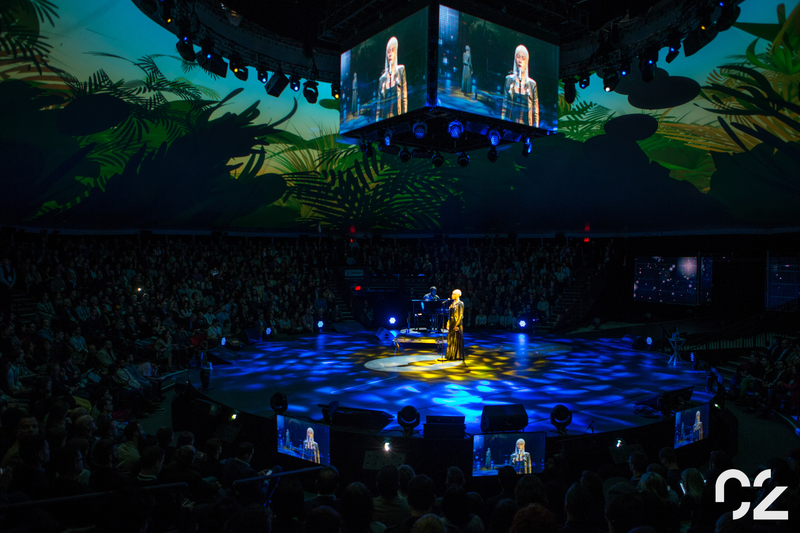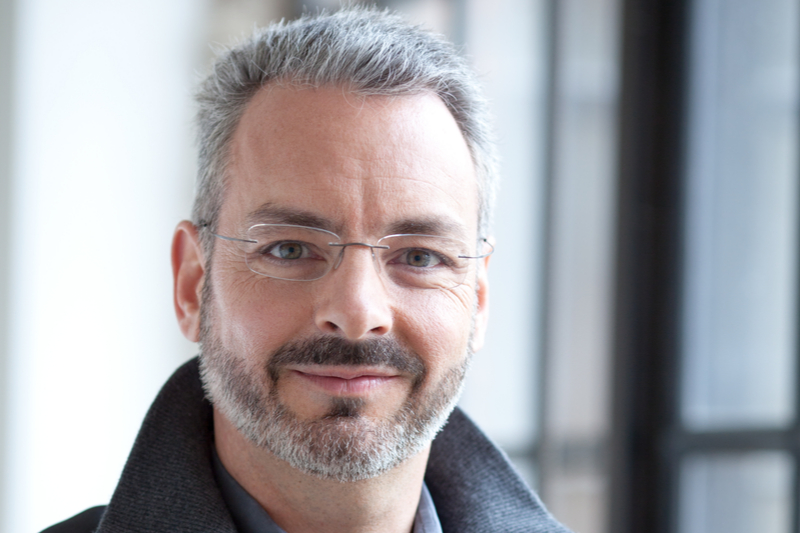How do you create the world’s most innovative business event? From booking speakers like Richard Branson, James Cameron, and Bozoma Saint John to creating networking opportunities in mid-air — the team at C2 Montreal has reinvented how we experience and connect at business events. We went deep with C2’s CEO Richard St-Pierre to learn how they do it — and what it really means to create “organized serendipity” on a grand scale.
The C2 Montreal innovation conference has been called the most forward-thinking business event in the world.
May 22-24, 2019, C2 Montreal welcomed over 7,000 attendees and 100 speakers from 60 countries and 34 industries to explore the future of business and society.
Previous speakers include Richard Branson, Bobbi Brown, Snoop Dogg, James Cameron, and Massimo Bottura — this year’s line-up was even more impressive.
But it’s the way the team at C2 facilitates 1-1 human interactions and designs immersive experiences, that really sets them apart.
We caught up with their visionary CEO Richard St-Pierre, who oversees C2’s international development and mobilizes the brightest, most influential minds from around the world in almost every industry you can think of.
What is C2 Montreal? What is your mission and philosophy?
We’ve been named most innovative business conference for the fourth year in a row [Bizbash] and a couple of weeks ago, “the most Kickass Experience” in the world by Eventex. That’s the actual label.
That one was particularly interesting because we also won the most sustainable conference in the world. This explains a bit who we are.
We’re basically about business convening in the 21st century. So what we want to have is a “convening” — that is, the analog version of the digital revolution that is happening.
These are the three main things that we set out to accomplish when designing C2:
First you convene, then you make them live an extraordinary experience, and third, deliver impact for them and for the community or company they represent.
How Did C2 start — what were the origins? The spark that started everything?
The origin of C2 goes back to close to nine years now. It was the end of the recession of 2008, 2009, and a group of business people — note I said business people — men and women, but not the government. They said, “what do we do for our city of Montreal?”
The recession had a lot of negative impact for Montreal, and Montreal was not as shiny as it should be. We love our city and got together and said, “how do we help Montreal shine again?”
So we said, how about we convene thousands of companies together and put them in the right environment — and we’ll create a number of miracles that we don’t control.
But by putting companies and business people together they will reinvent, they will create something new for the future of Montreal, and for the future of their countries.
And that’s the most impactful to influence society — if you’re not a government, that is.
That was the very basis, the basic foundation of C2.
What makes C2 different than other B2B conferences out there?
Typically if you think of a conference, you look at the roster of speakers and you expect to be sitting in a boring hotel — spending all that time, and then taking the plane back.
If you look at C2 and the program, the activities are actually reversed.
So, sitting down and listening to speakers is about 20 percent of what you can do, and 80 percent is everything else, from networking activities, workshops, labs, master classes.

Just to give you a ratio, last year we had a bit north of 100 speakers but we had 47,000 networking activities.
You see the ratio? Whereas for most people when they talk about a conference they’ll put all the budget, all the effort, and all the promotion towards their keynote speakers and there’s nothing else, you know?
Let’s face it, most of the conferences are downright boring, right? And if you try to make them un-boring, you end up with more lasers, bigger sound systems, and so on. Does that make that show better? Quite frankly does not.
For that reason, we design environments to be conducive for people to get together and talk to each other.
So you’re taking the conventional “binary” conference approach where an attendee is more of a passive listener, and turning it on its head in a sense — by focusing on 1-1 connectivity at scale?
Yes. Typically, connectivity is then basically just the coincidence that happens in front of the coffee shop.
But for us, this notion of human connection is central to what we do. It starts there, as opposed to starting with the stage.
So that also means looking at how we include food, how we include smell, how we include music — it’s all part of the journey that the participant experiences by coming to C2 that makes them human again.
Can you expand a bit on what that looks like in practice? The C2 team has a reputation for creating these unique collaborative experiences that also generate concrete opportunities — “Brain Dates,” “Connect Squad” and one of our favorites, “The Conversation Market.” How do these come into play?
First, I never use the word “visitors.” You know, most people attending conferences they look at the number of visitors or registrants or things like that.
We call them participants.
And since the participant is at the center of what we do, that means the participants have to participate. So they need to be engaged in a specific way. That is, they have a task to do when they come to C2.
So all the activities — from our Brain Dates, Labs, Conversation Markets — are made to break the ice and put everybody on the same level playing field. But in a really structured way — it’s more like a dating process.
The human touch is also very important. That’s where the concierge come into play. We’ll have almost 400 concierges that look at the profiles of the participants, and do some matchmaking ahead of the event.
We’ve tested this all around the world, by the way, and it works in every culture. Every culture, from Africa to Asia to North America, it works.
And it’s fun, because at the door opening the morning of C2, I’m personally welcoming the crowd, and we have more than 7000 coming in, so that’s a lot of handshaking.
There’s one fascinating networking experience you’ve created at C2 that is really unique — and it happens in mid-air (!) — your “Sky Lab.”
Our Sky Lab is where we put people in about 50 feet up in the air — but if you look on the floor, there’s a mirror. So that means when you’re up there in the chairs, you’re actually at double the height from how you perceive the height to be.

So it’s very scary.
But what happens when you’re scared? You don’t think about the fact that you have tattoos and that person in front of you does not. You don’t think about the fact that this is a woman or a man, old or young.
So we mix all these profiles and that’s when creativity happens because up there in The Lab, there’s a moderator that’s been there before and he’s asking pointed questions to that group that is scared for their lives.
But they’re exchanging in a meaningful way, via very conceptual but business-oriented questions. Both young and old meet up in the chairs and when they go back down, and they said, “wow, your idea was pretty good up there.”
It sounds like this experience creates a mutual vulnerability, and then people are more apt to connect? You’re connecting people who are very different on the surface — and in different industries — realizing they can add a lot to what each other is doing?
Correct. We create a level playing field that focuses on your good ideas, as opposed to who you are.
And so everything to do is about breaking the ice — you know, it’s hard for some people. But it doesn’t mean your idea is not good.
An Emirati, a minister from the UAE came to speak at C2 last year and I asked him, “what do you see?”
He said, “people are themselves here. They are open to being who they are.” And when you’re open to being who you are, you can create new things by talking to people in a more open fashion.
This year you booked over 100 speakers — everyone from Bozoma Saint John and Spike Lee, to Piera Luisa Gelardi (co-founder of Refinery 29), and Guy Laliberté (Founder of Cirque du Soleil). What is your approach to always booking such an eclectic mix of speakers while maintaining such a clear narrative?
It goes back to the principle I was talking about before.
We try to foster a collision of ideas.
In most events if you go to a cocktail mixer in New York after a couple of years, it’s always the same people that you meet.
Let’s face it. So how do you become creative, by being part of the same crowd?
So we’ll have the expert of AI for example. But we also have star power, people like James Cameron and Richard Branson.
This year we have a roster of well-known speakers of course, from Spike Lee to Bozoma — that’s my personal favorite, to be quite frank — but the speakers that have the most impact on the audience because we do a survey at the end — are all the “unknowns.”
That’s why it’s a collision of ideas. Because, how do you get an idea? It’s when your own are being confronted.
It’s the researcher from MIT, the woman that works in Africa to help certain villages and so on.
These are the most impactful speakers we have. And then, when you go back to the Labs and the Master Classes afterward, you have something to talk about.
Speaking of narrative, what are the topics or trends you’re most excited about for the upcoming C2?
Our topic or theme this year is Tomorrow.
And what I like about that theme is that it encompasses everything we’ve done for the past seven editions.
And why? Because there’s been an underlying mega-trend of transformation.
Every book and every magazine talks about industries being disrupted. Well, we’re kind of over that hump. Everybody understands that they were disrupted. Now we’re in the next phase of, “then what? What do I do?”
What do I do with this disruption? How do I position myself? What is the roadmap?
We’re breaking it down from AI to sustainability to the circular economy and all those things that are subsets of tomorrow — all of those things that will better equip the people that come to answer their question, “how do I transform?”
Because not everything is just about getting a deal. It’s also about getting an answer.
We want the person going and taking the plane back to his home base to feel good about the time they’ve spent, and now they have a plan.
They feel empowered with what comes next for them. Not because we told them something, but because they built it themselves, while being at C2.
What are the biggest challenges to producing and marketing an event like this? And how have you, or do you overcome them? I read somewhere that you completely reinvent your environment each time. Wow.
C2 stands for commerce and creativity, which means the first thing we need to do is to create, every year. That means that we start with a blank slate.
Every time, it’s not a repeat of the previous edition. We’ll reuse a concept, but we don’t reuse the environment. It’s something completely new — from the environments, the site, the labs, and the topics that we have.
If you’re resolutely in the 21st century, you don’t benchmark yourself about what’s existing or by integrating what’s in front of you — you benchmark yourself about what should be.
And it’s by creating a new path. And to create a new path you need to entice a spark of a new idea that the human brain is so great at doing if placed in the right environment.
So that means every participant that comes, even if they can’t come to every event we do, they will be surprised, shocked, and hopefully awed by what we’ve created.
There’s difficulty that goes into that because its very high risk.
And that’s obviously a huge challenge, to create something new every single time. How do you do that?
We have a team that believes it can be done. For example, the team right now is close to 140 people strong. But 90 percent of them are millennials. But I’m so proud of them because basically, the millennials are kicking ass.
And by running C2, the concept we have is control. That is, we don’t have any.
If the team comes to me with an idea, and I’m not scared a little bit, they haven’t pushed the envelope enough. And they know that. There’s part of this lack of control or un-control — so it’s not uncontrolled.
You let go of some of the things that you don’t know if that’s going to work, but you have to take a risk because that’s where you’re going.
You’re on the edge of something new.
We have a belief here that it’s essential to take a “URL-meets-IRL” approach. Basically, using your digital activities as a lead-up to foster great, in-real-life connections. How do you nurture this audience of participants year-round in between your events? Your new podcast? Instagram? Video?
I think the greater topic you’re referring to is engagement.
Of course, we do everything you’ve just mentioned, from Instagram to LinkedIn, and so on. And we have to. I don’t think that anyone has cracked the nut as to how do you really engage, in a sustained way, for a large-scale audience.
We had 800 million social media impressions during 72 hours of last year. That’s very good, but how do you sustain that throughout the year?
So we’re testing a number of things, one of which is The Aquarium. It’s basically a glass enclosure placed in the middle of the crowd, during C2.
When a celebrity like Spike Lee comes off stage, the next thing that person does is go into The Aquarium for a 15 minute interview with either a journalist or even a completely unknown person.
So we try to establish that dialogue that happens when two people are on-site. We’re trying to extend it in the digital realm. That’s the next kind of Holy Grail.
Something very interesting also happens on the last day of C2 — very different than a lot of trade shows and conferences out there.
It sounds a bit maybe too spiritual but I insist on being the last speaker of C2 every year. So I’m out onstage, and do the, you know, the concluding words, the thank yous, and everybody applauds. That’s the obvious thing.
But the feeling I look forward to is, when I walk on that stage, I can literally, like, lean on the energy of the crowd.

The empowerment that everybody’s got in that room is enough to sustain me and honestly, levitate me from the stage.
Usually on the last day of a conference everybody’s looking to book their flight and go back home. But we’re completely packed.
Why do people stay until the last minute of C2, when they can go back to their things? It’s because they see the value of doing so.
They want more of that.
And that’s the difference that C2 brings.
You’ve probably seen a thousand things happen, but is there one surprising or fascinating thing that really sticks out for you, since you’ve been the CEO of C2?
Overall, I think the quote I would use is “organized serendipity.”
When I see the thousands of people coming in, honestly, I’m scared. And so is my team. Because we don’t know what the outcome will be.
There was this small company, from a small city close to Montreal. They had three people, and they wanted to teach entrepreneurship through music to elementary grade students.
They met with a Chinese school entrepreneur and now about three years later, they have more than 200 schools that are using that curriculum to teach entrepreneurship to Chinese people.
Had they not been at C2, that would never have happened.
James Cameron was also at our event a few years ago. We had him meet a company called Felix & Paul.
Felix & Paul were two just out-of-school guys that happened to create new software for VR goggles before Oculus Rift happened.
They met with James Cameron at C2, and now Felix & Paul is the most prize-winning company in the world for VR, and they are based in Montreal.
And that happened just because of that James Cameron meeting.
So the real surprise I have every year is that by letting coincidence and serendipity play its role, to a certain extent, we’re actually contributing to making the world a better place.
####
You can still register for C2 Montreal here.
By Jed Wexler, 818 Agency’s CEO and Editor-in-Chief. My conversation with Richard was edited for clarity and concision.




